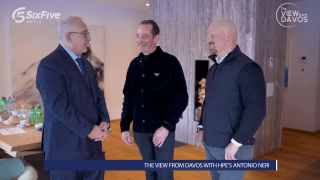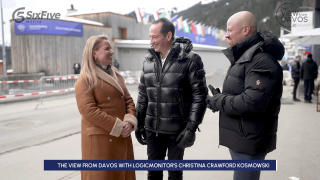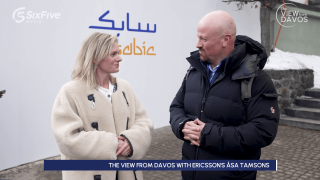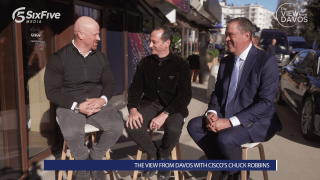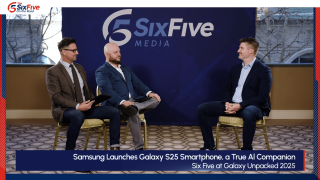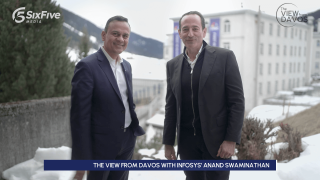This special episode of Six Five Media On The Road reveals exciting news shared by Intel and AMD CEOs, Pat Gelsinger and Lisa Su, exclusively with hosts Patrick Moorhead and Daniel Newman about a groundbreaking new collaboration that marks a significant shift in the tech industry, aiming to drive advancements and innovation at unprecedented speeds.
Their discussion covers:
- The strategic vision behind the Intel and AMD partnership
- Expected impacts on the X86 ecosystem and the broader technology landscape
- Innovations and advancements anticipated from this collaboration
- How this partnership positions Intel and AMD against competitors
- The long-term goals and outcomes both companies aim to achieve
Watch the full below:
Or listen to the audio here:
Disclaimer: Six Five On The Road is for information and entertainment purposes only. Over the course of this webcast, we may talk about companies that are publicly traded and we may even reference that fact and their equity share price, but please do not take anything that we say as a recommendation about what you should do with your investment dollars. We are not investment advisors, and we ask that you do not treat us as such.
Transcript:
Patrick Moorhead: The Six Five is On the Road here at Lenovo Tech World 2024 in Seattle. There’ve been some incredible announcements here, a lot of CEOs on stage, personally and virtually, supporting what Lenovo is doing. One of the biggest announcements, a pan industry announcement, is that AMD and Intel are coming together to extend the x86 platform. Dan, can you believe this? Isn’t this great?
Daniel Newman: Yeah, it’s a big moment. The headlines are out there calling, what is happening? But this is a really important inflection, Pat, and I think this goes to show that there’s a moment where architecturally things coming together to drive the future of the industry, it’s important and you can clearly see it when you’ve got these two companies… Two companies, should we say who they are?
Patrick Moorhead: Sure, sure. I think I already did, but we’ll do it again, AMD and Intel. But it was more than that. It was really the Titans in the industry, in software, in platform. So why don’t we dive in here and you can guess that we have AMD’s Lisa Su and Intel’s Pat Gelsinger. Welcome two of you. It’s funny, sometimes you get that feeling when you were a kid, you see your teacher in the grocery store and are like, “Oh my gosh, you buy groceries too?” And to have the two of you here is truly exceptional. Thank you so much.
Pat Gelsinger: Well, thank you.
Dr. Lisa Su: Thank you. It’s great to be here.
Daniel Newman: What a great analogy. So Pat, let’s start off talking a little bit about what this means. Of course, there’s the x86 side of this, and that’s really big. It’s getting a ton of attention. But what about on the software side, AVX, AMX extensions? Give us the extent of this collaboration.
Pat Gelsinger: Yeah. And it really is bringing together, as you say, the titans of the ecosystem.
Daniel Newman: That’s right.
Pat Gelsinger: Obviously, we’re agreeing to facilitate this, but we’re really looking with the ecosystem partners and particularly the software vendors. To me, that’s the most important piece of this, because essentially, why do you build hardware? To run software. So it’s agreeing on what the system interfaces, application interfaces need to be, because often we had differences between us that were slowing, not accelerating, the ecosystem. It’s really about how do we collaborate on agreeing what the interfaces need to be at the system level? How we have operating system and system level support for that. But then also, how it embodies itself into the application stack. And for that, things like AVX and AMX, it’s not like one is good or bad, but it is saying when we’re not aligned, we don’t accelerate people’s ability to bring applications onto the x86 architecture. And as the two companies that by far have been leading this over time, us coming today together in this way and saying, we’re seeking the input of the ecosystem to help guide that evolution, yeah, that’s a big deal.
Patrick Moorhead: Yeah, it’s interesting. I obviously interact with all of your ecosystem, and of course, I didn’t talk to them before this, but what they’ve told me in the past, this is a big step forward here. But I have to, Lisa, what’s the genesis of this collaboration? How did it start? You and Pat, your companies were working across your partners at some point, but how did it start?
Dr. Lisa Su: Well, let me just add to some of the things Pat said. Look, this is a really important day for the ecosystem and it really is about the ecosystem. We have a shared goal, which is to get the best compute out there and to do it in the most effective way possible. When you think about x86, it really is the architecture of the last 40 plus years in terms of where all compute innovation has happened. And what we’re really trying to do here is really bring the ecosystem together where we have an opportunity to accelerate the pace.
So back to how this happened, so Pat and I do see each other from time to time at various industry events. And the truth is, we hear a lot from customers that they appreciate x86, they appreciate all of the technology, but boy could AMD and Intel make it easier for them. So I think that is a foundation of it. And then we brought some of our teams together. It started actually with our CTOs, Greg Lavender, Mark Papermaster and some of our technical team. And what we found is, there’s really a deep respect between these teams. I mean, yes, we compete, but these are two of the best processor teams in the industry. And at the end of the day, we want to get innovation out there as fast as possible. So it was a very natural thing. I think this is the right moment just given everything that’s happening in infrastructure and AI for us to bring the ecosystem together.
Patrick Moorhead: I appreciate that.
Pat Gelsinger: It felt a little surreal. Because hey, I’ve been a firsthand witness to some of these debates and squabbles and lawsuits and so on, the deeply held different opinions in the industry. So when I was in Lisa’s boardroom, when she was in our boardroom, it was like, wow, I never thought I was going to be here. But as Lisa said, it’s the right thing for the industry. It’s the right thing for the ecosystem. And unleashing more energy around the x86 ecosystem, that’s a shared objective. And one, when you have a shared goal, a shared vision, okay, now you can look past the past and look forward together to the future.
Patrick Moorhead: Yeah, I have to share with you, I mean when your teams messaged me for the first time, I mean, I was Intel’s biggest customer and I worked at AMD, and I’ve covered you two for 13, going on 14 years now in my company. And yeah, it was quite an event and I knew there was collaboration going on across with engineers. Engineers seemed to get along better. But in the end, trying to give the customers what they want. Now it’s official, it’s direct access. So again, I just think this is a huge step forward for x86 and your customers.
Daniel Newman: Pat, so often we talk about on our shows and with guests about how competition is great for the market, but collaboration can be great for the market too. And I think this is one of those cases where they can continue to compete fiercely and I expect that you will.
Pat Gelsinger: We will.
Daniel Newman: But you can also collaborate in a way that drives a ton of value to customers expanding the market. And Lisa, you mentioned that expanding the market, you talked about it in the release. And what does that mean? Because you dominate in so many parts of the market already. Is it about embedded? Is it mobile? Where does this go?
Dr. Lisa Su: Well, I think this is really about all of the above. I mean, the idea is x86 is, when you look at x86, and you look at our customer set and you look at the applications, yes, we are everywhere today, but the market is moving very fast right now. There’s a tremendous amount of innovation, whether you call it architectural innovation, implementation innovation on the software side, on the application side, and with all of that, the purpose of this advisory group is to really allow our customers, our partners, and frankly our teams, to move faster. And really our focus is, there’s going to be a lot of opportunity for us to differentiate. I mean, if you look at just the spectrum of compute that you require across all these applications, but there are some places where if we work with the advisory group together and agree, we will actually move the ecosystem faster. And that’s what this is about. That’s how we expand the market, frankly, is by getting more innovation out faster.
Patrick Moorhead: No, that’s great. So questions always come down to timing. So I’m curious, and we’ll start with you, Pat, when would we expect to see the first fruits of the labor here?
Pat Gelsinger: Well, I think in some ways you already are, right? Because I think just sending this message to the ecosystem, I think people will all of a sudden pause and say, huh, can I go partner with them? Can I go look at the x86 through a more forward-looking lens than I had before? And we’re already having those conversations, some of the cloud guys and say, so I can influence this and think about how I shape the x86. And whether that’s at the application level, whether that’s at custom product levels, whether that’s at the chipset level, chiplet level, whether that’s new use cases. So I believe that today, you already will start seeing that difference of ecosystem energy being unleashed. That said, we’re going to get underway. We will have the first advisory group meeting. And I’d also emphasize when you have people like Tim and Linus in the room, you have technical heavyweights.
Patrick Moorhead: Sure.
Pat Gelsinger: As I’m talking to Linus-
Patrick Moorhead: Very outspoken. Very outspoken.
Pat Gelsinger: And they don’t waste their time in that regard. They’re going to expect results. They’re going to expect influence or they’re not going to spend their time on this. So these are impatient heavyweight folks. And you look across the other companies that are participating in it, they’re putting their best people on it. We raised the bar pretty high. And I said, you have to sit in the same room with Tim and Linus so don’t send people that can’t sit in the same room with them and have good technical conversations. These are quality individuals that have invested enormous amounts of energy around the x86 ecosystem, and have huge amounts of their own technical credibility associated with that, but they’re business as well. So they’re looking for results and we have to show up. And then of course, we’re going to go compete viciously for who’s the best at implementing that guidance.
Dr. Lisa Su: I just want to add to what Pat said though. The other thing that was true is as we came up with this idea and reached out to the partners, every single one was super energized by this. So the idea of bringing these people together, basically the best of the best in terms of architectural minds to define where x86 goes next, I think really resonated with all of our founding members.
Patrick Moorhead: How do you envision the future of x86?
Dr. Lisa Su: Well, again, I mean, maybe I’ll start Pat and you can add. Look, I think what we have here is the x86 architecture has again evolved over the last number of decades to really be the best architecture for high-performance compute. Now we think about AI, we think about efficiency, all of these aspects of it, and the key for us is to keep attacking the problems of tomorrow. At the end of the day, we’re looking at where does the architecture need to evolve to really scale from cloud to enterprise, to edge, to client, to mobile, to auto, across all of those spectrums? And so this is an opportunity for us to evolve. Now, the beauty of x86 is the fact that because of its long history, many of the traditional compute applications have really come to rely on that capability. But yes, we’re looking at where x86 is going to go over the next 40 years.
Pat Gelsinger: And just maybe a couple of more concrete examples to put against that. I mean, obviously GPUs and accelerators are super important for AI workloads, but almost all of the data, databases, embeddings, rag use cases are running on the x86. How do you tie those things together? Because people aren’t going to import their thirty year old databases just to take advantage of an accelerator and move all of that code over. How do you stitch those two together? Hey, that’s a pretty important topic for us to figure out of how we extend the x86, not just the native instructions like AVX and AMX, but also how do you extend memory spaces? How do you have coherent memory access from the CPU to the GPU? Super important topic. Security model, I started working on security in the underlying platform with TPX 25 years ago. The amount of deployed confidential computing today is pitiful.
The recent crowd strike issue, hey, that should have been resolved in minutes, not weeks or months associated with it. We can do much better at that. When you think about new segments, automotive, a car is a computer with tires today. Okay, we have the best computing architecture that runs more of software forever, so how do we standardize and just make that an extension of the x86 platform? When you think about the legacy of the x86, you go into these environments and people say, “Well, I run all of my test instrumentation and validation environment on x86, even for non 86 environments.” Why? Because it’s been built over the last two to three decades. Why would I ever replace it if it works and is functional? So I think the long tail being able to be brought forward is a super powerful asset of the ecosystem as well.
Patrick Moorhead: Thanks.
Daniel Newman: So as we bring this conversation to a bit of a close here, I have to ask this. The people that are out there, they’re going to watch, they’re going to say, okay, is this publicity? What’s going on? You’ve got the two of you very convincing, of course. But how will this collaboration continue to be found in the wild? And maybe Lisa, why should those that maybe are a little skeptical feel that this announcement has legs, is real, and that you’re very committed to this?
Dr. Lisa Su: Well, I think you can just take a look at it’s not just AMD and Intel, it’s really all of the giants of the industry around computing today. And we have a common goal. The common goal is to move the industry forward. And for that reason, I think this advisory group is actually, it’s exactly the right time to bring something like this out. It’s an opportunity for us to move the industry faster. It’s an opportunity for really what hasn’t existed before, which is for frankly, the industry ecosystem to give us really very clear feedback on what’s needed. And let me just say, Dan, one of the things I say is we’re not necessarily, don’t think of this as an x86 thing. This is really a computing industry thing. What are we doing to move the industry forward? And that’s why today’s a very important day.
Pat Gelsinger: And this is also measured by the intellectual horsepower that’s part of the advisory group as well. And I would just say, look at the names that are part of this. They care. They wouldn’t waste their time. They’re pretty intent on this. And they’re building on the investment that many of them have for decades. And here we are at Lenovo World as we’re having this conversation. They built their entire company on the x86 and that’s the case for many of the companies that are participating so they’re not going to suffer their time randomly. They’re investing to make a big impact as a result of the tremendous legacy that we have, the most powerful software ecosystem that’s ever been built on earth and now we’re committed together to extend it.
Daniel Newman: And a great reminder from both of you about the ecosystem. It’s not just Intel and AMD, but a number of partners, founders and advisors being involved. And for everyone out there that wants to learn more, check out Pat’s… Pat wrote a great Forbes article published this morning, dives deep into this. Pat, Lisa, thank you both so much for taking the time, for making this happen and for allowing us to be part of this historic moment.
Pat Gelsinger: Yeah. Well, thank you.
Dr. Lisa Su: Thank you.
Daniel Newman: And thank you for tuning in, being part of The Six Five community. Hit that subscribe button. Join us for all of our content here, and of course, across the technology space. But for Patrick, myself, we got to say goodbye for now. We’ll see you all later.


